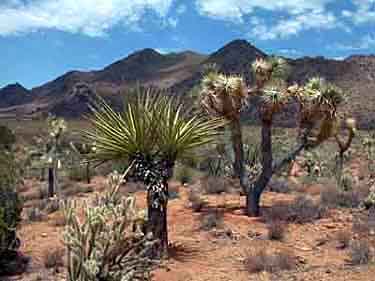NATIVE PLANTS
| A primary reason for our choosing this particular spot for the development of a desert garden was the large existing natural diversity in the plant communities, both in the area as a whole and on the 40-acre property itself. In the extensive search for suitable sites to carry out our vision, we had to make a choice. Would we prefer to have a garden in the region where the dramatic and charismatic saguaro cactus grew, or was it better to opt for a place with a forest of the equally impressive and unique Joshua tree? The decision was shaping up to be difficult, since both vegetational zones had their merits. Upon further investigation, however, we learned that there were a relatively few spots in northwest-central Arizona where the two zones intergraded ecologically, and thus we focused on that region. Most of the land in this part of Arizona is not available for private ownership, having been assigned to the jurisdiction of the Federal government under the Bureau of Land Management (BLM), the State of Arizona, or Native American tribes. But, eventually, we found for sale an affordable property with great botanical potential southeast of Yucca, Arizona (itself named for the presence of Joshua trees). We offer some plants for sale, info here. |
|
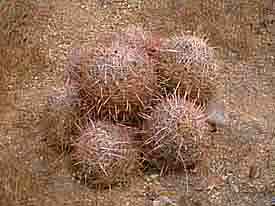 |
|
An unusual red barrel cactus (Ferocactus acanthodes) with 8 heads. These are usually a single-stemmed species |
The region is what is known in biological circles as a transition zone, which is any place where one major ecosystem type changes over to another. Commonly used examples are where forests change to meadows, or where fresh water rivers flow into the salty oceans. Transition zones are generally known to have a higher biotic diversity than single ecosystems, since there is a mix of species from both areas. In order to fully appreciate the diversity of the spot where Destination: Forever Ranch and Gardens is located, we'll discuss the three ecosystems that blend together here. These three ecozones, as they are sometimes called, are the Mojave Desert, the Sonoran Desert, and the Arizona Interior Chaparral zones.
THE MOJAVE DESERT
The Mojave Desert is the smallest of the four American Deserts in size. Some ecologists consider the Mojave to be a mere subset of the Great Basin Desert to the north and the Lower Colorado division of the Sonoran Desert to the south. A more recent and widely held view, however, classifies the Mojave Desert as a distinct ecoregion in its own right based upon unique biology, climate patterns, and geographical characteristics. This is the view we will adopt for the purposes of this discussion.
The Mojave Desert is a very dry desert, with large areas receiving only 3 to 6 inches of rainfall per annum. Both the desertís southerly latitude and the fact that most of the rain occurs during winter, when it is cold, makes this a rather trying environment for the plants and animals. Long, torrid, bone-dry summers strictly limit the numbers and types of plants able to survive here. Temperatures well in excess of 110 degrees F (43 degrees C) are quite the norm, with little to no chance for rain and the relief it might bring. Despite these taxing circumstances, over 1000 plant species have been recorded from this desert, along with hundreds of bird, mammal, and reptile species. There are even several fish and frog species living in isolated desert springs that live nowhere else on earth!
| This view shows just how exuberant annual desert wildflowers can be in a year of favorable precipitation. The perennial prickly pear cactus serves as a stoic backdrop for the magenta-rose brushes of purple owlís clover (Orthocarpus purpurascens), clear yellow Gordonís bladderpod mustard (Lesquerella gordonii), and the sky-blue wands of the bulb-forming perennial bluedicks (Dichelostemma pulchellum). Although this scene was taken near Superior, Arizona, in the Sonoran Desert, similar spring displays of different species can occur in good years in the Mojave Desert | 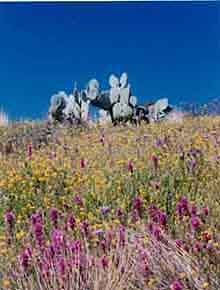 |
The most characteristic plant of the Mojave Desert is the Joshua tree (Yucca brevifolia). The ecological boundaries of this desert are closely bounded by the distribution of this remarkable tree. Found only in the United States, the Joshua tree cuts a strange and striking silhouette against the evening sky as the sun sets. Creosote bush (Larrea tridentata) is also very widespread in the Mojave, and is the dominant shrub over thousands of square miles of valley land. The highest diversity of plants, however, belongs to a group rarely seen. Known as annuals, or more properly, ephemerals, many of these species are tiny (under 2 inches tall) and very short-lived, under 2 months in many cases. They spend most of their time as seeds, lying dormant for years on end waiting for the correct conditions of rainfall and temperature to bring them forth into a brief and sometimes raucous color display lasting mere weeks. Many of these species appear only once every 5 to 10 years. Some varieties may wait 20 or more years for the right chance to bloom! It is estimated that close to 70% of the Mojave Desertís plant species have adopted an ephemeral lifestyle in response to their unusually harsh environment, the highest rate of such adaptation in the US.
THE SONORAN DESERT
Also found here is what is known as the Sonoran Desert. The Sonoran is a low-altitude desert by and large, and is the only North American desert to reach the sea, along the Sea of Cortez and the Pacific Ocean in Sonora and Baja California, Mexico. It is a truly subtropical desert, with tropical affiliations at its southern extent in Mexico. Frost is rare and mild, even in the northern parts, and the pattern of having biseasonal rainfall contributes immensely to its overall diversity and unusual plant and animal life. The two rainy seasons are winter, generally December to March, and summer, from July through September. Areas around Tucson, Arizona and north of Phoenix, Arizona may receive as much as 16 inches (40 cm) of precipitation per year, which would in most cases rule them out of the desert classification (10 inches or less annually). But the high temperatures and unpredictability of timing and quantity of rainfall prohibit the survival of plants unable to adapt to such a pattern, and therefore these areas can rightly be called desert. Most of the Sonoran Desert does receive significantly less than 10 inches of rain per year, however.
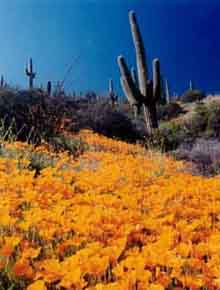 |
The wildflower display of spring 2001 was probably the best one that the Sonoran Desert has seen in nearly 30 years. Here a riot of Mexican gold poppies (Escholtzia mexicana) pave the desert slope in front of a stand of giant saguaros (Carnegiea gigantea) |
The saguaro cactus (Carnegiea gigantea) is native to this desert, and has been poached as a symbol for all deserts, although it is not found outside of the Sonoran. As with the Joshua tree, the distribution of the Sonoran Desert corresponds closely with the distribution of the saguaro. The organ pipe cactus (Stenocereus thurberi) also lives here, and differs from the saguaro in that it has many branches rising from ground level rather than one single trunk with branches held well above the ground. In fact, the Sonoran Desert is in large part characterized by its large number of columnar cacti, most of which are found to the south in Mexico, not in the US.
Other prominent plants in the Sonoran Desert are small trees in the legume family. Among these are the palo verdes (Cercidium floridum and C. microphyllum), the mesquites (Prosopis species), and the acacias (Acacia species). Indeed, there are so many small trees in this family and others in the Sonoran Desert that it is sometimes called an arborescent desert, meaning treelike. Deserts are not generally known for having many trees of any size, and this is one feature that sets the Sonoran apart from the other North American desert regions. There are too many weird and wonderful plants in this desert to list here, though we hope that a fair selection of them will be grown on the D:FR property. Stay tuned for progress reports....
ARIZONA INTERIOR CHAPARRAL
Many people have never even heard of this life zone, but it is distinct to Arizona. It covers a fairly extensive geographical area in the central mountains of the state, and is recognized for a number of differing characteristics that separate it from other ecoregions. As its name suggests, it is found exclusively within the state of Arizona, and occupies a moderate-elevation band in the foothills and mountains from about 3000 feet up to about 6500 feet, depending on the site.
Chaparral is a term applied to densely shrubby vegetation in semiarid sites. The height of said vegetation may range from 2 or 3 feet up to over 10 feet. Chaparral zones are wetter than the deserts below them, but drier than the forests above them. Rainfall averages from 12 to 25 inches annually, and tends to be more evenly distributed throughout the year than in deserts. Snow and frost are quite common given the higher elevations. The shrub cover can be very thick, often approaching 100%, making the soil surface hard to see and difficult to traverse, especially in shorts. In fact, the chaps that cowboys wear on their legs were created to prevent painful encounters with the tough prickly leaves and sharp twigs. The derivation of the term chaps becomes apparent. Chaparral is itself a Spanish word for a stand of a common Mexican shrub known as chaparro.
Chaparral is very fire prone. The devastating fires that occur every year in the coastal chaparral of Southern and Central California are testament to this fact. From an ecological standpoint, chaparral is designed to burn and requires it every 10 to 30 years for best plant health and highest species diversity. If deprived of fire for too long, the ecosystem declines, and fuel loads build up to intolerably dangerous levels. When the inevitable fires do occur then, they do more damage to both the ecosystem and the nearby people and their structures.
Some of the plants found in this zone are a large number of oak species (Quercus turbinella, or scrub oak, being prominent), sugarbush sumac (Rhus ovata) with its very handsome, shiny heart-shaped leaves, Arizona rosewood (Vauquelinia californica), and silk tassel bush (Garrya wrightii). Many penstemons (Penstemon species) are found here, and are deservedly popular garden wildflowers in the Southwest. Conifer trees, mainly pines and junipers, reach in from the mountains zones above the chaparral zone. Cacti can be found here as well, although they are not as common because the fires tend to discourage their abundance under many circumstances.
A THREE-WAY TRANSITION ZONE
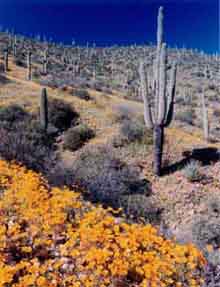 |
A colorful understory of Mexican gold poppies covers the slope in a dense forest of saguaro cacti near the town of Globe, Arizona in March 2001 |
What makes the property that Destination: Forever Ranch sits on unique is that elements from all three of the ecological life zones described above are found here. The Mojave Desert lies to the north and west, the Sonoran Desert lies to the south, and the Hualapai Mountain range holds an island of chaparral and coniferous forest at the higher elevations to the east and north. We have conducted an ongoing survey of the plants found on the 40-acre D:FR property over the last 3 years. Thus far, 165 plant species have been identified. Of these, about 40% to 45% are annuals that spend most of their lives as dormant seeds. We were fortunate that the winter of 2000-01 yielded an excellent combination of temperature and rainfall, bringing out all the ephemerals and making it possible to catalog their presence. This favorable occurrence also resulted in the best spring wildflower season that Arizona has seen in nearly 30 years. It also brought out many of the perennial plants which had been difficult to identify in a gray, leafless state, although they were visible above ground level. It ought to be noted that the 165-odd species list is not yet complete. In a place as complex as the D:FR property, there will without doubt continue to be new discoveries not yet seen in other years with differing combinations of rainfall and temperature from 2000-01. It also bears mentioning that the 165-species list includes only natives and naturalized exotics, not plants introduced and cared for by the master gardener. Furthermore, it also includes only plants actually found on the 40-acre site. If plants growing nearby (within 2 to 3 miles) were included, the list would easily jump to over 200 species, and, if the scope were further widened to include a 10-mile radius, that number could easily double again.
Following is an incomplete plant list of the area, designed to showcase the diversity. Not all plants are found on the property:
- at least 16 species of cactus
- at least 7 species of yucca, agave, and nolina
- at least 4 bulb species
- at least 12 tree species
- at least 50 woody shrub species
- at least 30 perennial herbaceous wildflowers
- at least 50 annual wildflowers
- at least 20 lichen species
- at least 5 moss species
- at least 3 fern species
- at least 1 liverwort species
